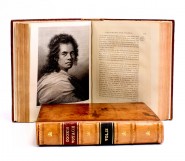Lot #118 - Wimmitji Tjapangati
-
Auction House:Mossgreen
-
Sale Name:Australian Indigenous & Oceanic Art
-
Sale Date:22 Jul 2014 ~ 6.30pm (Part 1 - Lots 1 - 198)
23 Jul 2014 ~ 2.30pm (Part 2 - Lots 199 - 331) -
Lot #:118
-
Lot Description:Wimmitji Tjapangati
(circa 1925-2000)
Nyinmi (1990)
synthetic polymer paint on linen
120 x 85 cm -
Provenance:Warlayirti Artists, Western Australia (435/90); Songlines Across Australia Collection, Melbourne
-
Notes:This painting is sold with a Warlayirti Artists certificate. For an artist whose career spanned only five or so years, Wimmitji Tjapangarti remains enormously influential in the ongoing story of Balgo art. He produced a relatively small number of acrylic paintings throughout his career, but the best of them are the best of paintings. Wimmitji walked to Balgo Mission in the late 1950s; the last of his family to leave the desert. In 1957 he was at Natawalu (Well 40) on the Canning Stock Route when his family group famously encountered a helicopter for the first time. The evacuation of a sick Helicopter Tjungurrayi to Balgo by a survey team (with a helicopter) is now part of desert lore, as is the travel of his family members north to find him. Wimmitji followed behind this group later with his first wife, Wongwiya. He was an important figure in Balgo, and became influential in shaping outsiders' understanding of Aboriginal language and culture. Wimmitji was a key contributor to the mythological research of anthropologist Ronald Berndt, and consulted closely on both the Kukatja Dictionary and Fr Anthony Peile's study of Kukatja concepts of health, Body and Soul: an Aboriginal View. Through teaching language, explaining concepts, and ultimately painting Country, Wimmitji proved himself a determined and uniquely gifted illuminator of his world. Wimmitji's art, like his Country, is dominated by the creative acts of the Tingari ancestors. Yet his paintings are not girdled by the early conventions of men's Tingari painting - grids of site-paths or circle-line compositions. This is no doubt partly because of the intimate collaborative relationship he enjoyed with his second wife, Eubena Namptijin. No meaningful discussion of Wimmitji's art is possible without observing the influence husband and wife had on each other's paintings. But Wimmitji's unique artistry was also clearly visible across his oeuvre. Nyinmi, a sunlit lattice of curious tangents and confident trajectories, is a wonderful example of this. Wimmitji rarely painted the same place twice, and when he did it was only to paint another part of the story, in a completely different composition. His paintings were paths worked out in the walking. The classic circle-line structures of desert art are evident in Nyinmi, but they are pulled and stretched, stopped and followed around the canvas in searching ways. In this painting two Tingari women (their feet at bottom left) travel around, collecting foods and holding ceremonies; the Country itself was created in the wake of their actions. The journeys of these ancestral women are carved into the raised fields of dotting, the paths on the canvas mirroring the meaningful marks they left on the world. But the paths of the Tingari ancestors here are the negative space, thrown into relief by the bright world Wimmitji weaves around them. Compositions such as Nyinmi read as if there were no formula but to follow the song; and in this the canvas is animated by the music of Wimmitji's own process as much as the songs of his ancestors. Dr John Carty
-
Estimate:A$18,000 - 25,000
-
Realised Price:
-
Category:Art
This Sale has been held and this item is no longer available. Details are provided for information purposes only.










